What makes Ujazdowski Castle especially magical is the fact that it does not really exist.1
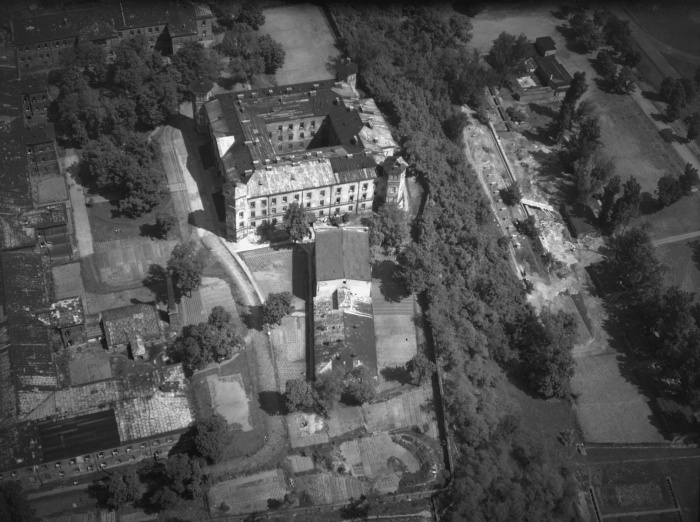
Zamek Ujazdowski widziany z lotu ptaka, 1944. Autor nieznany. Źródło: (c) Archiwum Deutsches Dokumentationszentrum für Kunstgeschichte - Bildarchiv Foto Marburg, Nr. fm931407
A castle is a symbol of resilience and permanence: “[M]y home is my castle.” But when we come up with feeble ideas or projects based on shaky ground that have little realistic chance of ever succeeding, we are said to be building “castles in the sky.” The bulk of Ujazdowski Castle, since the 1980s the home of the Centre for Contemporary Art, stands at the same time for both these contrasting connotations – possible and failed dreams. Its “powerful” contemporary architectural form disintegrates into multi-threaded, fragmented narratives as soon as questions are asked about the history of the building and its past residents. In the 19th century, this former seat of royalty and grandees was haunted by the suffering and death taking place in the army hospitals and the Ujazdowski Hospital. The post-war relic, turned into its own ruin, can now produce only phantasms about museums that can make time stand still: of Warsaw, the Vistula, revolutionary movements or decorative art. The Centre for Contemporary Art proved the final nail in the coffin of the metaphor of durability and the supremacy of knowledge and authority, by retaining the former name of the edifice: Ujazdowski Castle. This “brand-new historic relic,” cut off from the city by a green belt – and in winter – by darkness, conceals traces of past memory that we pass by with indifference. The panorama-viewing terrace, erected on the ruins of Warsaw leans forward in a futile effort to reach out to the future.
This sketchy outline of the castle’s history allows one to treat the structure as a palimpsest “in which the content of the place becomes a tool in the service of an ideology, used and transformed according to the purpose it is to serve.”2 Successive managers of the building’s symbolic sphere kept subjecting it to ever more alterations, whether of its plan, architectural form or purpose, until at the end of the 18th century, the castle was turned into army barracks and hospitals, a role it was to fulfill for some considerable period.
Advances in military medicine in the last quarter of the 18th century abruptly ended the series of symbolic and spatial corrections; its representational functions were subjugated to strictly utilitarian rules. The castle’s regular foundation, typical of a defensive structure, softened by baroque cupolas on the polygonal towers, with the domed cupola above the avant-corps added by the last king, is somewhat at odds with the desired idiom of soldierly ascetics, as would be in keeping with the decision taken by the Four-Yearly Sejm, or Parliament, to field a hundred-thousand-man strong army.3
The 19th century was a time of a slow fading away for the castle. Decorative elements on the façades were brutally chopped off or curtailed; the four-columned porticos stand to attention lording it over all the stories.4 Classicism is pulling the wool over our eyes. For the hospital, monumentalism is neither here nor there. Willy-nilly, through its architectural dominance, the castle became part of the landscape of the barracks. When, in the course of the 19th century, the main structure kept being slimmed down, the hospital out-buildings kept growing and multiplying. It was only Piękna Street5 that was to stop their expansion. Now weakened, the architectural form could no longer provide defense. The moaning of the wounded invaded the delicate wafting sounds of courtly dances.
Until 1945, the castle kept changing hands like a hot potato: from Poles, to Russians, then Prussians, back to Poles, Germans, finally falling into the hands of the Polish and Soviet army.6 As is well known, the castle could not withstand the post-war “acculturation” and, in peacetime, died at the hands of the enemy.
The contemporary history of Ujazdowski Castle belongs – to employ a term proposed in 2004 by Marta Leśniakowska – with a “strategy of oblivion,”7 which erases objects and events which are inconvenient for consecutive, culturally contradictory or ideologically hostile power systems.
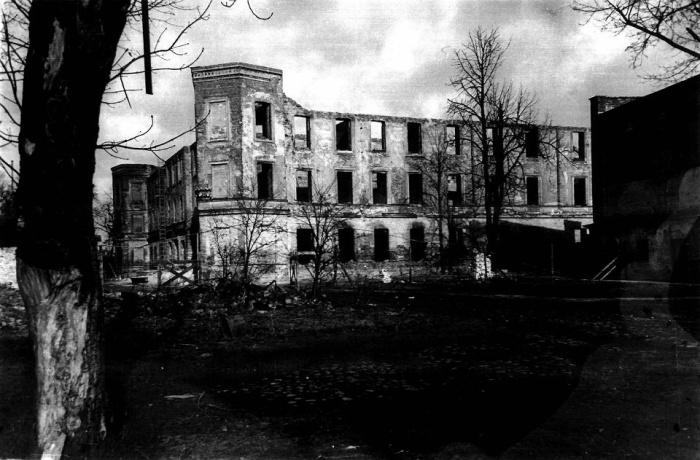
Fotografia wypalonego Zamku Ujazdowskiego tuż po wojnie. Autor nieznany. Źródło: zbiory Muzeum Zamku i Szpitala Wojskowego na Ujazdowie.
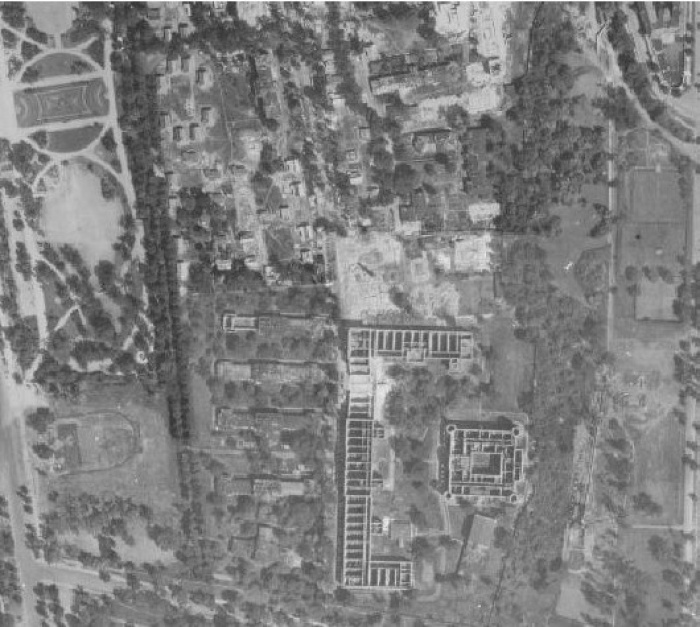
Zdjęcie lotnicze ruin Zamku Ujazdowskiego, 1945. Źródło: Urząd Miasta St. Warszawy, http://www.mapa.um.warszawa.pl/mapaApp1/mapa?service=mapa_historyczna
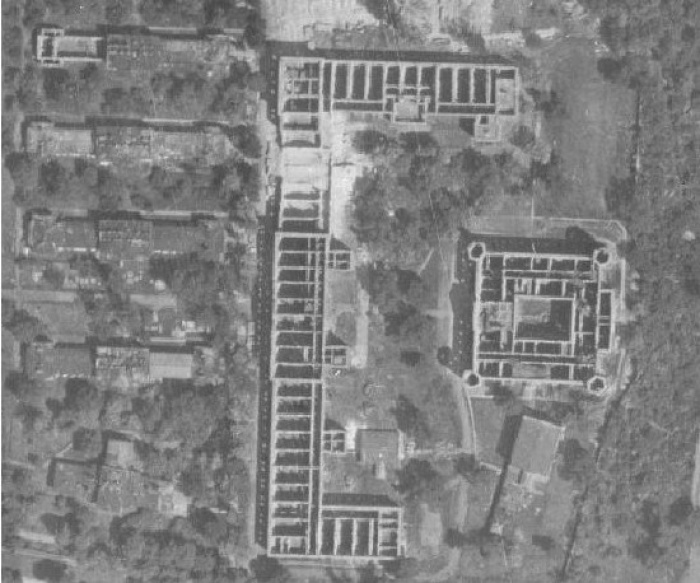
Zdjęcie lotnicze ruin Zamku Ujazdowskiego, 1945. Zbliżenie. Źródło: Urząd Miasta St. Warszawy, http://www.mapa.um.warszawa.pl/mapaApp1/mapa?service=mapa_historyczna
I would like to pause at the term “oblivion” – for I think it is the first time8 that it has appeared against the backdrop of art history, and in the context of a critical reading of the history of a place: Warsaw. In sociological research, “oblivion” is defined as “socially significant gaps in the collective memory. Thus if we take memory to mean the accumulation and recording of information, it follows that oblivion is everything that lies beyond that area, including both content that has not been absorbed and that which has been eliminated or forgotten.”9
“Oblivion” is a form of unconscious self-censorship or, for Piotr Tadeusz Kwiatkowski, the creation of a “blank spot” around a past event, reinforced by leaving it unnoticed and unmentioned, passing in silence over those aspects that are not rooted in contemporaneity, and thus do not lend themselves to being “utilized”10 in the everyday praxis of the community. These aspects are never, however, irretrievably lost. As Kwiatkowski notes, these events “are out in the open, that is to say they have been socially confirmed and are accessible or lost in a reversible way, making them relatively easy to retrieve.”11
Marta Leśniakowska treats “oblivion” as a potentiality, a place made vacant and once more ready to receive a “new memory.”12 To her mind, in post-war Warsaw, the post-King-Stanisław classicism pushed by curators imposing an ideologically desirable aesthetic onto the capital was just such a “new memory,” which sanctioned the homogenous character of the city of socialist realism.13
One consequence of “oblivion” was the instrumental treatment of the reconstruction of Warsaw as a tool of propaganda, turning the city into its own full-scale model, filling the sites of vanished buildings with their simulacra; today, extreme manifestations of this approach are tourist attractions, and urban architectural reservations, such as the Old Town or the Royal Route.14 The goal of the post-war policy of a “new memory” for Warsaw was a conservative, processed landscape. 15
From this vantage point, Ujazdowski Castle16 more than fulfills its part in the ideological project. Piotr Majewski, the author of one of the most comprehensive monographs on the post-war conservation of historic relics in Poland and its embroilment in politics, perceives the demolition of Ujazdowski Castle in 1954 as one of the post-war “devastation practices” carried out on historical objects.17 In his opinion, the “planned closing off of the Stanisław Axis with the monumental edifice of the theatre of the Polish Army has inflicted [...] probably the greatest loss on Warsaw since the end of hostilities.18 The reconstruction of the castle, already embarked on before 1947, was finally dropped in April 1949.19 An article by Witold Kieszkowski – art historian and historical conservator as well as the author of an unfinished monograph on Ujazdowski Castle,20 which upheld the merit of the surviving relics of 17th architecture – published in the April issue of “Stolica” of that year seems to be the last plea directed at the authorities by those in favor of the reconstruction. The deputy director of museums and historic preservation during 1946–1949 refers to the destruction wreaked by the war as a “lucky coincidence,”21 which had removed once and for all “makeovers later than the baroque, which had disfigured the castle.” Amongst his rhetorical arguments, there is an invocation of the castle’s links to the “history of Warsaw” and the “tradition of the Piast dynasty [sic!] of Mazovia.” The correspondence between the conservators in the Office for the Reconstruction of the Capital quoted by Piotr Majewski proves unequivocally that what stopped the reconstruction of the castle was the fact that a high-level decision by the party authorities had not been forthcoming, the indecision caused by a lack of clarity as to the use to which the reconstructed building would be put.22 As the researcher notes, the “correspondence does prove, however, that not all the solutions had been finalized by the conservators, either”23 – which could be interpreted as a slow-grinding process of “oblivion.”
Today, no one remembers any longer the competitions for the Warsaw Uprising Monument, that the post-1948 political changes finally put the brakes on, or the idea for a Liberty Mound, planned originally to be erected “from the ruins of heroic Warsaw”24 on the allotments between Paderewski Park and the Vistula, or the fact that it was Ujazdowski Park25 that was put forward as yet another potential site for the Liberty Mound to be fashioned – by the people of Warsaw – as a burial mound made from a pile of the “ruins of the places in Warsaw most affected by suffering.”26
From 1949, the burnt-out perimeter walls of the castle, now standing close guard over a vacuum, had been waiting in vain to be filled with meaningful content. The brick curtain, three-meters tall replicated the now-non-existent perimeter. The “brick fence” – as Józef Sigalin, Warsaw’s chief architect in the days of Stalin, called the brick wall around the former Ujazdowski Hospital – was no more. Screened by trees from Ujazdów Avenue, the route taken daily by the government cavalcade, it had become invisible.

Zamek Ujazdowski widziany z lotu ptaka, 1944. Autor nieznany. Źródło: (c) Archiwum Deutsches Dokumentationszentrum für Kunstgeschichte - Bildarchiv Foto Marburg, Nr. fm931407.
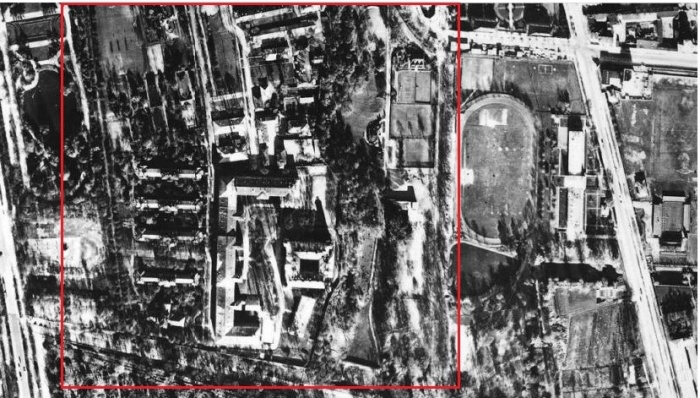
Zdjęcie lotnicze z zaznaczonym obszarem Zamku Ujazdowskiego, 1935. Źródło: Urząd Miasta St. Warszawy, http://www.mapa.um.warszawa.pl/mapaApp1/mapa?service=mapa_historyczna
The grove of lime trees, as Sigalin metaphorically calls the trees that grew “during 1946–1971” where the Łazienki Route now runs,27 is no more than a remedial fantasy. It evokes an Arcadian landscape, nature ennobled on the leftovers of matter.28 It is only in Warsaw that lime groves appear suddenly after a storm. The “new memory” could neither constitute itself around the castle nor take residence within it. In Józef Sigalin’s recollections from that period, even as late as 1950, the terrain between Czerniakowska Street and Ujazdowski Castle was earmarked for a people’s park. The elevations were to be restored as a mere shell, the surrounding land exposed and accessible from the direction of Na Rozdrożu Square.29
In Poland’s post-war history, 1953 marks both the beginning and end of something. In a Polish newsreel of April of that year, we can see a large male hand moving a model of the future House of the Polish Army across a scale model of Warsaw.
The scale model was filmed at the BOS architectural exhibition, which accompanied the National Architects’ Council in 1953. The hand belonged to Romuald Gutt, whose design for the House of the Polish Army had surmounted the professional hurdles and, as a “new object rather than a reconstruction,”30 had been accepted for implementation. In May, during the absence of Jan Zachwatowicz, who was the most committed to the idea of reconstruction, the castle was demolished. The professor’s final meeting with the Polish Prime Minister Cyrankiewicz (who was said to have spread his hands in a gesture of helplessness and whispered that he “couldn’t do anything”) is now a historical anecdote in the public realm.31
The rhetorical figure of the “lime grove” marks, for me, the punctum that arrests our attention, but also the flow of my text that is growing as the castle is shrinking. The lime grove evokes a bucolic familiarity that masks the ultimate destruction. Sigalin allows himself to indulge in a nostalgic dream: where limes had grown until 1971, there was, we are told, “[F]irst a large church, followed – once it had been dismantled – by an exhibition area, then a skating rink, and later still the famous summer café Łobzowianka. Nearby, towards Agrykola Street, there was ‘Rau’s garden’ (a children’s playground).”32 A paragraph further on, the author puts right this memory lapse with an image of nothingness and necrosis: “Na Rozdrożu Square – ruined buildings, the broken, half-burnt trees of Ujazdowska Avenue. Towards the embankment – a field, a scarp covered with weeds. Architects have taken over the surviving outbuildings of the former Ujazdowski Hospital, along with urban planners, and engineers, who in BOS waste no time in getting down to the task in hand. The long army barracks – burnt out, completely cut off Na Rozdrożu Square from the scarp. The Ujazdowski Castle walls – burnt out. Nearby – the first settlement of Finnish-style houses.”33 The carefree world of the 1920s has been replaced by a dialectic image of reconstruction;34 there is progression towards the future in what has “survived.” The people’s park, planned in 1950, simulates the insouciance towards the despised world and introduces the merry din of the – ideologically preferred – working masses, complete with the vernacular.
Let me close my brief reflections by returning to “oblivion” as a means of regulating post-war memory practice related to Warsaw, especially the official policies. For this is how one probably ought to interpret Marta Leśniakowska’s analysis. The transfer of “oblivion,” it is implied, should be hierarchical – those who control symbolic space manipulating it deliberately, as well as manipulating end-users without inside knowledge. These end-users would be the new inhabitants of Warsaw, incessantly writing their own, “smaller narrative” of the capital. For this laborious task, the “homely,” spontaneous colloquial language of the users’ home or region was insufficient. For the vernacular to “enter wider circulation, succumb to requirements that came from outside and transcend its own sphere of existence,”35 it must become interlocked with other languages. The officialese must be absorbed, or so to speak processed into the vernacular as “newspeak.” It was thanks to such a lingua franca of the post-war regime that the new users of Poland’s largest ruined city were able to gain communicative proficiency in their places of work and were able to understand the idolect of the authorities, for instance that was used in the mass media. It would have been useful to also have referential language that could have provided access to the, until then, external symbolic zone (culture), as well as mythical language (since the late 1940s, the heroic narrative of Warsaw has been made sacrosanct).
Is there a place for the Castle in the “smaller text” of Warsaw? There is not, it seems. The mutually exclusive communications of the authorities did not make it easier for the new residents to assimilate the castle/Castle; the nuanced and self-consciously rhetorical statements by conservators did not help, either. In the early 1960s, the remnants of the building, covered in grass, were preserved as a “permanent ruin.” The construction of the Łazienki Route had set in motion the reconstruction mechanisms that had become dormant in the 1950s. Today, the older brother of the Royal Castle stands on the same scarp as it did in the old days, but in a slightly different way. The interiors, given a baroque flavor by the reconstruction touches of Piotr Biegański, who had previously worked closely with Jan Zachwatowicz, are again pervaded by referential language, the language of contemporary art.
The castle’s “oblivion” now comes in two distinct parts. One could ask whether against the background of Warsaw memorology there has appeared any “antihegemonic discourse.”36 Has our Castle not become, to put it in general terms, “discoursified”? It does not seem so. The “permanent ruin,” the small brick wall finally became the kiss of death to the historic past of the Castle.
The baroque-like maquette had arrived out of the blue to replace the vacuum, rather than an emptiness “post-.” Processed for the “underinvested vernacular layer” of the local memorology, it was able to return to the post-war narratives, put on ice in 1954, and once more be reworked ideologically.
The castle’s repressed military and insurgent past has nestled silently and discreetly in one of its downstairs halls; it is not invasive. It does not intend to occupy and take over the space. Members of the public visiting the Ujazdowski Castle Centre for Contemporary Art are not looking for an anachronistic and exclusive islet of old papers. The Centre uses a hyphen to cut itself off from the castle even if only in name, and seeks to flee the periphery, dragging its own vernacular in the direction of global art.37
U-jazdowski Castle is thus not a hybrid. The museum of the Ujazdowski Hospital is barely an incidental, down-trodden appendage, fed mythical, proverbial crumbs off the table. The stability of the reconstructed structure only undermines the memory of nature. The scarp churns sand like an hourglass.38 It is unlikely that the rubble of the ruined castle will stop oblivion in its tracks.
*Special thanks to Zuzanna Sosnowska for her help in searching through the archives.
Translated from the Polish by Anda MacBride
Ewa Toniak – is an art historian, doctor of humanities, and Assistant Professor in the Faculty of Theatrology at the Aleksander Zelwerowicz Theatre Academy in Warsaw. She is interested in the relationships between art, space, and autobiographism, as well as in cultural memory and contemporary narratives about the People’s Republic of Poland. She is the author of the books: Olbrzymki. Kobiety i socrealizm (2008, 2009), Śmierć bohatera (2015), Prace rentowne. Polscy artyści między ekonomią a sztuką w okresie odwilży (2015). Academic editor of Kobiety i sztuka ok. 1960 r. (2010), Pamiętnik Sztuk Pięknych. Vol. 9, Sztuka polska 1944-1970 (Toruń: Uniwersytet im. M. Kopernika, Warszawa: ISnSŚ, 2015), Natalia LL. Secretum et Tremor (2015), Kobiety i sztuka ok. 1960 (2010). Author and curator of exhibitions including Alina Ślesińska (1926-1984) (2007), Trzy kobiety: Maria Pinińska-Bereś, Natalia Lach-Lachowicz, Ewa Partum (2011), Wolny strzelec (Zachęta National Gallery of Art, 2013), Moore and Auschwitz (Tate Britain, 2010), Natalia LL. Secretum et Tremor (CCA Ujazdowski Castle, Warsaw, 2015). She is a recipient of scholarships from the government of the Republic of France and the Ministry of Culture and National Heritage of the Republic of Poland. AICA member. She lives in Warsaw.
*Cover photo: Ruins of Ujazdowski Castle right after the World War II. Author Unknown.Source: Museum of the Castle and Military Hospital at Ujazdów.
1 Krystyna Pawłowska, Idea swojskości miasta, Kraków 2001, p. 156.
2 Aleksandra Wójtowicz, Pałac Staszica jako heterotopia afektywna – refleksja humanistyczna w planowaniu przestrzennym, “Teksty Drugie,” 6/2014, p. 307. The category of palimpsest describes – for the purpose of assigning the Castle to military uses: the history of the garden founded as long ago as in the 17th century, which owed its final shape to the last King of Poland Stanisław August Poniatowski. As Mateusz Salwa observes, “A garden is not merely an accumulation of the results of the preceding changes, but rather a continuous process of transformations that also have repercussions on the past, while at the same time preparing the ground for the changes to come,” cf.: id., Estetyka ogrodu. Między sztuką a ekologią, Łódź 2016, p. 125. The devastated trees in the Ujazdowski Hospital park were replaced as early as 1946, so the policy towards the trees had been the same as towards the architecture.
3 The field hospital in Ujazdowski Castle had been planned as a general one, with the best-trained workers. The war in 1892, the Kościuszko Uprising, and finally the partitions of Poland abruptly ended these plans.
4 Stables and a coach house were added; also annexes built on the square, with an internal courtyard.
5 In 1852, J.K. Volck finally transformed the mass of the castle, removing all architectural detail and lending the edifice a severe appearance, in keeping with its function.
6 More on the history of the Ujazdowski Hospital: http://www.zamekujazdowski.art.pl/, [accessed: 10 September 2017]; cf.: Jazdów, ed. Edward Rużyłło, Warsaw 2008; Ujazdów: 730-lecie Jazdowa i 200-lecie najstarszego szpitala wojskowego Warszawy: materiały z sesji naukowej, czerwiec 1992, Warszawa 1994
7 Marta Leśniakowska, Warszawa XX wieku: strategie niepamięci, in: Rocznik Warszawski, R. 32 2004, pp. 147–154. In my reflections on “oblivion” about the post-war fate of Ujazdowski Castle I was inspired by the text by Roma Sendyka, Niepamięć albo o sytuowaniu wiedzy o formach pamiętania, “Teksty Drugie,” 6/2016, pp. 250–266.
8 In 2014 “oblivion” as a descriptive category appears in the title of the monograph by Maria Poprzęcka on Royal Łazienki. Cf.: id., Łazienki – pamięć i niepamięć, Warsaw 2014.
9 Maria Hirszowicz, Elżbieta Neyman, Społeczne ramy niepamięci, „Kultura i Społeczeństwo,” 2001, no. 3/4, p. 24.
10 Piotr Kwiatkowski, Społeczne tworzenie zbiorowej niepamięci, in: Etniczność, pamięć, asymilacja. Wokół problemów zachowania mniejszości narodowych i etnicznych w Polsce, ed. Lech Nijakowski, Warszawa 2009, p. 91.
11 Ibid.
12 Marta Leśniakowska, Inne czytanie miasta. Brak i addenda jako krytyczne historie sztuki, in: Kultura artystyczna Warszawy XVII-XXI w., ed. Andrzej Pieńkos, Zbigniew Michalczyk, Michał Wardzyński, Warszawa 2011, p. 318.
13 Ibid., p. 315.
14 Ibid., p. 318.
15 Ibid., p. 315.
16 In the immediate post-war lexicon, a symbolic battle for the designates of the past also touched on the names: the Castle of the Mazovian Dukes versus Ujazdowski Castle, which inevitably brought to mind the wartime occupation of the military hospital. At that time, the hospital bore the name of Marshal Józef Piłsudski.
17 Cf. Piotr Majewski, Ideologia i konserwacja. Architektura zabytkowa w Polsce w czasach socrealizmu, Warszawa 2009, p. 218.
18 Ibid.
19 Ibid.
20 All the materials for the monograph perished in a fire during the war.
21 Witold Kieszkowski, Zamek Ujazdowski, „Stolica,” 16/17, 1949, p. 7.
22 Piotr Majewski, op. cit., p. 216.
23 Ibid., p. 217.
24 Cf. (ed.), Gruzy męczeńskiej Warszawy w kurhanie pomnika Wolności, “Życie Warszawy: pismo codzienne,” R. 3, 1946 no. 143 (25 V), p. 5.
25 Ibid. “Kurhan” evokes the topicality of the cemetery, excluded from the heroic discourse of rebuilding Warsaw. Ujazdowski Park and the area of the former Military Hospital functioned as a cemetery. Stanisław Jankowski mentioned this explicitly in 1956: “The project, put forward some 10 years ago, was later passed over in silence, as if unimportant. That silence was wrong, harmful. It planted a seed of bitterness into our most treasured memories. It deprived us of our right to a great, communal experience.” In: id., Warszawski pomnik, „Obywatel Warszawy,” 10, 1956, p. 10.
26 Already in 1945, the workers demonstrating in the Warsaw Power Station under the slogan “Long live the memory of the Warsaw Uprising” and put forward to the Party authorities a plea that a competition be organized for an appropriate monument. On the history of the subsequent siting of the future monument, see Irena Grzesiuk-Olszewska, Polska rzeźba pomnikowa w latach 1945-1995, Warszw 1995, pp. 24–32.
27 Dense tree stands are visible in airshots taken in 1944.
28 Cf. Józef Sigalin, op. cit., vol. III, p. 364. The lime tree, with its connotations of rustic bliss, has a special place in Polish culture, first evoked by the great Renaissance poet Jan Kochanowski, it is also employed in an evocative simile by the nineteenth-century writer Bolesław Prus in his novel Pharaoh: to convey the affluent splendor of the residences of the ancient Egypt, he likens the rows of acacias and sycamores that surround their houses to our lime trees, as the highest accolade. However, it was quite different trees that the authorities intended to plant on the land cleared of the military hospital, surrounding the Castle from the side of Na Rozdrożu Square, as we can read in “Dziennik Ludowy” from April: “In Górny Ujazdów, where the Finnish houses and the BOS Department, housed in the outbuildings of the former Ujazdowski Hospital, there are plans to complete the present, partly devastated stand of trees, by planting such species as rowan, Californian pine, viburnum, spiraea, veigelia and hazel, and the landscape will be emphasized by planting hedges of flowering currant and berberis bushes.” Domki fińskie na tle zieleni. Wiosenne sadzenie drzew, „Gazeta Ludowa: pismo codzienne dla wszystkich,” R. 2, 1946 no. 101 (11 IV), p. 6; see: (J), Warszawa znów się zazieleni. Rozpoczęto prace zadrzewienia stolicy, „Życie Warszawy: pismo codzienne,” R. 3, 1946 no. 106 (16 IV), p. 5.
29 According to a note on 3 April 1950, at the meeting of the Council of the Bureau for the Reconstruction of the Capital, a decision was made about Ujazdowski Castle, with the proviso: “The final decision on how Ujazdowski Castle is to be used will be taken separately.” After: Józef Sigalin, Warszawa 1944-1980. Z archiwum architekta, vol. 2, Warsaw 1986, pp. 404–405.
30 Cf. Piotr Majewski, op. cit. p. 216.
31 Cf. Jerzy.S. Majewski, Wojna z wojskiem o Zamek Ujazdowski. Zburzyli go 60 lat temu, http://warszawa.wyborcza.pl/warszawa/1,34889,16267889,Wojna_z_wojskiem_o_Zamek_Ujazdowski__Zburzyli_go_60.html; [accessed: 11 September 2017].
32 Józef Sigalin, op. cit., T. 3. pp. 466–467.
33 Ibid., p. 467.
35 Cf. Krzysztof Pijarski, „Lśniąca ruina” – fotografia, socrealizm, mit odbudowy, [w:] Kultura artystyczna Warszawy XVII–XXI w., op. cit., p. 395.
35 Roma Sendyka, op. cit. pp. 250–251.
36 Ibid., p. 264.
37 The new name and logo of the Centre for Contemporary Art is now: U-jazdowski.
38 Warsaw was built on sand dunes - shifting sands in more sense than one. In 2000, the geotechnical company Geotest tested the water and soil conditions prevailing on the Warsaw scarp on which Ujazdowski Castle stands. On the company’s webpage we can read that “the ramparts are constructed with fine sand mixed with brick dust. At the foot of the scarp at the depth of 4.00 meters, drilling had been carried on an old foundation or brick wall 2 meters thick! The wall rests on tertiary silt. For fear of the terrain collapsing, the scarp was reinforced.” Cf.: http://www.geotekst.pl/artykuly/historia/zamek-ujazdowski, [accessed: 17 September 2017].



